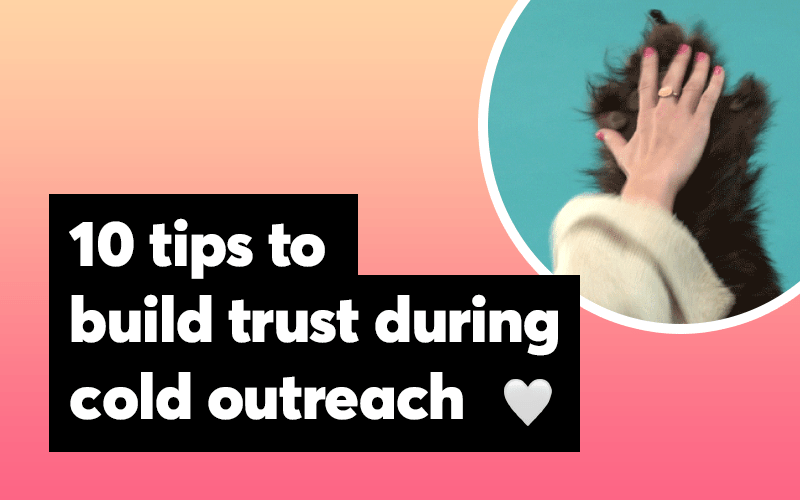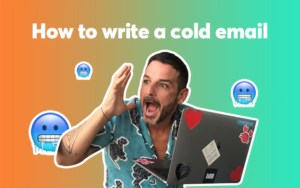Cold outreach is considered a necessary evil by many. It’s a key way of winning new customers and clients in many industries, yet it’s a tool that has a notoriously low success rate.
But building trust during cold outreach can substantially increase conversion rates at every stage of the cold outreach process.
So, read on if you want to learn the best ways of building trust when you’re reaching out to prospects cold so you can win more sales and grow your business consistently and sustainably.
Research your prospect — The foundation of all trust-building techniques
The most important tool in your arsenal when it comes to gaining the trust of cold prospects is to research them, and if you’re a B2B organization, research their business as well.
Understanding your point of contact and their business gives you lots of information you can use to your advantage including:
- An understanding of their pain points enables you to speak directly to their challenges and even solve some of their problems. This enables you to prove you can solve their problems through freebies and lets you explain how you can solve further problems once they’re a customer.
- Insight into their likes and dislikes enables you to keep every engagement with your prospect positive.
- Knowledge of any commonalities with you and/or your business, so you can use the law of similarity to increase your success rate.
- An understanding of their preferred communication method and style so you can deliver your messages in the way that’s going to resonate most strongly.
- Knowledge of their recent wins so you can grab their attention and instantly build rapport by congratulating them on their successes.
Personalize every message
Once you’ve done your research, you’ll have the information you need to personalize every cold message you deliver. This doesn’t mean you can’t have templates that enable you to scale your cold outreach. But it does mean you can insert a few key tidbits that will help you quickly and efficiently build the trust of your prospects.
Why is personalizing cold messages important?
Well, think about all the cold outreach messages you receive. What do you think of the ones that clearly follow a standard template? I bet they don’t make you feel special. In fact, I bet they inspire you to hit ‘delete’. That is, if you even bother to open them.
A personalized message on the other hand speaks directly to the prospect and encourages them to actually read or listen to the message.
It makes them feel special and begin to like you. It can even be the thing that gets them to take action.
Personalized videos are for example good at giving a personal touch to your email (even more when you use a solution like Checksub.com to add subtitles on your videos).
Here’s a fantastic example of the power of personalization.
Jon Torrey is a senior product manager and hosts two podcasts, so he’s fairly well known. As you can imagine he receives lots of cold emails and, like many of us, he deletes most of them unread.
However, one day he received one that he not only opened but acted on. Part way through the third sentence he was even thinking:
“You want to send me free stuff. You saw me on with Gary V, and you have ties to Philly and the University of Vermont!? Suplexed is now my favorite app and I don’t even know what it does!” Jon Torrey, on Medium.
As a result of just one cold message that was really well personalised to him, Jon delivered several endorsements of the brand that got over a thousand engagements. Not bad for one cold email.
Obviously, your messages aren’t always going to be that personalised. In fact, you may never have the opportunity to personalise your messages that much. But even a little personalisation goes a long way.
Here’s an example of a personalised email template that was sent to prospects who had failed to secure a specific type of government grant.
Each template is only personalised with the recipient’s name, but the personalisation is taken further because the email was designed for a specific segment of prospects.
Another email template was used for prospects that didn’t meet the criteria for that email template.
This is another great example of how you can personalise your messages while still using templates.
Show you understand the prospect’s problems
If you do your research well, you’ll have a good understanding of the problems your prospects are facing. When you show you truly understand those problems, your prospects will be more likely to trust that you understand their needs. And they’ll be more willing to investigate whether you can be trusted to solved their problems.
Deliver value for free
If you take it a step further and actually solve one or a few of your prospect’s problems during your cold outreach, you not only demonstrate that you understand their needs. You also prove that you can solve their problems.
Once you’ve done that, it’s much easier to convince your prospect to shell out cash for a paid solution to another problem that’s bugging them.
This might sound expensive and time-consuming, but it’s really not.
Solving a prospect’s problem for free might be as simple as sharing a blog post or video with them that tells them how to overcome a challenge.
These kinds of resources can also do double time by attracting inbound traffic from your target market if you do a good job of optimising them for search engines.
Know and express your value
Once you get down to explaining what you do, don’t bother describing the features of your offerings.
Focus on the benefits and value you can deliver to your prospect.
Not only is this a classic way of convincing people to buy, but it’s also a great way to inspire trust.
Now, you might think that conveying your value would do nothing to increase trust because prospects know you can say whatever you want about your products and services and that doesn’t mean it’s true.
But one of the fastest ways to erode trust is to be unable to confidentially express your value.
After all, if you can’t describe the value you bring to the table, that probably means you don’t actually bring any value.
At least, that’s what your prospects will think.
Use social proof
Name-dropping is often frowned upon as an uncouth practice not befitting of polite society.
But if you can tell your prospect that you’ve solved a problem similar to the one they’re facing for a well-known brand in the same industry, you plant the thought that ‘if X brand found the product/service useful, maybe I will too’.
There’s also an element of FOMO (fear of missing out).
Don’t ask for the sale at first contact
Building trust takes time. Only 2% of people will buy on first contact, partly because asking for the sale too soon is a great way of destroying trust.
Yet many sales professionals give up too soon.
92% of salespeople give up after a prospect says no four or fewer times. But 80% of prospects say no four times before they say yes, partly because tenacity inspires a certain amount of trust.
After all, if someone will ask for a sale five times, they probably believe very strongly in the ability of their offering to benefit the prospect.
Also, it’s worth noting that many people just aren’t ready to buy when you first contact them, so you need to keep following up with them to maintain trust and keep your offering at the front of their minds for when they are ready to buy.
So, give yourself a chance to build real trust with your prospect by waiting for a little before you ask for a sale. And then follow up several times before you think of giving up.
Be consistent and fulfill your promises
Along the same lines as the previous point, when you promise your prospect something, make sure you deliver on the promise. For example, if you say you’ll follow up in a few weeks, put a reminder in your calendar to do so. Or better yet, schedule an email follow up as soon as you make the promise.
By keeping your promises, even small ones like that, you create the expectation that you are a person of your word. In other words, someone they can trust. When you do this consistently, it almost becomes unthinkable that you might not be as trustworthy when it comes to your paid offerings.
Provide additional value during follow up
While the act of following up is vital, the way you follow up is even more important as the right followup can go a long way towards building trust.
Many people say something like ‘just checking you got my email’ or ‘just following up on my message’ or ‘just calling to see if you’ve had a chance to consider my offer’.
This gets the follow-up job done and builds a little trust if you’re making good on a promise to follow up at a certain time. But it doesn’t do much else.
Instead of this approach, you can build a lot more trust if you follow up with additional value.
For example, you could call them saying you’ve just published a new blog post that could help them overcome a challenge that’s common for people in their position and ask them for permission to email or message it through to them.
Or if you’ve already established an email relationship (or a relationship on social media), you could email it directly to them. Other types of content you could share include videos, podcast episodes, eBooks, and even case studies.
Or you could invite your prospects to a free webinar or other event.
However you choose to provide value to your prospects, just make sure it actually does provide value. There’s no point sharing a resource if it’s not relevant to your prospect.
Create a professional, useful email signature
Even if you primarily conduct cold outreach via phone, at some point you’ll almost certainly need to send an email, even if it’s just to send a copy of a contract or receipt etc.
When sending emails, a professional email signature helps build a little more trust and makes it easier for prospects to get in touch with you if needed.
On the flip side, having an unprofessional signature can substantially erode trust.
So, what does a professional email signature consist of?
All professional and effective signatures include the following:
- Name
- Professional title (if relevant)
- Organisational position and the organisation’s name
- Phone number (with the international prefix for those working internationally)
- Email address (some people say this is a waste of space, but it’s very useful when prospects share the signature with their contacts)
- Website
- Office address (if relevant)
- Social media links (professional profiles only)
- Headshot photo and/or the organisation’s logo (colour photos of people are especially memorable and help to build rapport)
- A call-to-action (banners are especially effective)
- Social proof
- An appointment booking link
Depending on your goals, you might also include one or more of the following:
- A link to your latest content
- A newsletter subscription link
- A banner with your latest deal or offer
- Seasonal promotions
- Holiday greetings with a link to a promo page
- A link to a page about your mission and services
- A link to a video presentation of your services
- Customer reviews or testimonials
Here are a couple of examples of professional signatures that build trust.
Start building trust during your cold outreach
No matter how you’re using cold outreach to generate and convert leads, your success rates will be so much higher if you work on building trust in cold outreach with your prospects. Some of the best ways to do that are by researching your prospect, personalising your messages and delivering lots of value before asking for the sale.
Most importantly, prove you can solve your prospects’ problems for free, and they’ll be more likely to believe you can solve bigger problems with a paid solution.
Discover also a guide to presentation videos.







 BONUS:
BONUS: The Challenge: Join this free course and I guarantee that after 5 days you will have the necessary skills to start generating B2B clients Growth Hacking and Prospecting techniques.
The Challenge: Join this free course and I guarantee that after 5 days you will have the necessary skills to start generating B2B clients Growth Hacking and Prospecting techniques.